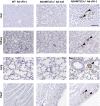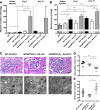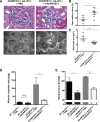ADAMTS13 Endopeptidase Protects against Vascular Endothelial Growth Factor Inhibitor-Induced Thrombotic Microangiopathy
- PMID: 26038528
- PMCID: PMC4696577
- DOI: 10.1681/ASN.2014121165
ADAMTS13 Endopeptidase Protects against Vascular Endothelial Growth Factor Inhibitor-Induced Thrombotic Microangiopathy
Abstract
Thrombotic microangiopathy (TMA) is a life-threatening condition that affects some, but not all, recipients of vascular endothelial growth factor (VEGF) inhibitors given as part of chemotherapy. TMA is also a complication of preeclampsia, a disease characterized by excess production of the VEGF-scavenging soluble VEGF receptor 1 (soluble fms-like tyrosine kinase 1; sFlt-1). Risk factors for VEGF inhibitor-related TMA remain unknown. We hypothesized that deficiency of the VWF-cleaving ADAMTS13 endopeptidase contributes to the development of VEGF inhibitor-related TMA. ADAMTS13(-/-) mice overexpressing sFlt-1 presented all hallmarks of TMA, including thrombocytopenia, schistocytosis, anemia, and VWF-positive microthrombi in multiple organs. Similar to VEGF inhibitor-related TMA in humans, these mice exhibited severely impaired kidney function and hypertension. In contrast, wild-type mice overexpressing sFlt-1 developed modest hypertension but no other features of TMA. Recombinant ADAMTS13 therapy ameliorated all symptoms of TMA in ADAMTS13(-/-) mice overexpressing sFlt-1 and normalized BP in wild-type mice. ADAMTS13 activity may thus be a critical determinant for the development of TMA secondary to VEGF inhibition. Administration of recombinant ADAMTS13 may serve as a therapeutic approach to treat or prevent thrombotic complications of VEGF inhibition.
Keywords: VEGF; thrombosis; von Willebrand Factor.
Copyright © 2016 by the American Society of Nephrology.
Figures





Comment in
-
Endothelial Dysfunction: The Secret Agent Driving Kidney Disease.J Am Soc Nephrol. 2016 Jan;27(1):3-5. doi: 10.1681/ASN.2015050502. Epub 2015 Jun 2. J Am Soc Nephrol. 2016. PMID: 26038532 Free PMC article. No abstract available.
References
-
- Besbas N, Karpman D, Landau D, Loirat C, Proesmans W, Remuzzi G, Rizzoni G, Taylor CM, Van de Kar N, Zimmerhackl LB, European Paediatric Research Group for HUS : A classification of hemolytic uremic syndrome and thrombotic thrombocytopenic purpura and related disorders. Kidney Int 70: 423–431, 2006 - PubMed
-
- Rosove MH: Thrombotic microangiopathies. Semin Arthritis Rheum 43: 797–805, 2014 - PubMed
-
- Bianchi V, Robles R, Alberio L, Furlan M, Lämmle B: Von Willebrand factor-cleaving protease (ADAMTS13) in thrombocytopenic disorders: a severely deficient activity is specific for thrombotic thrombocytopenic purpura. Blood 100: 710–713, 2002 - PubMed
Publication types
MeSH terms
Substances
Grants and funding
LinkOut - more resources
Full Text Sources
Miscellaneous

